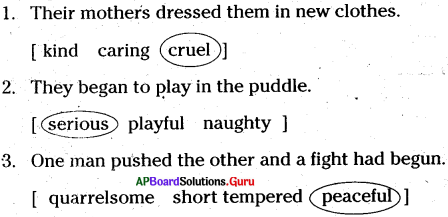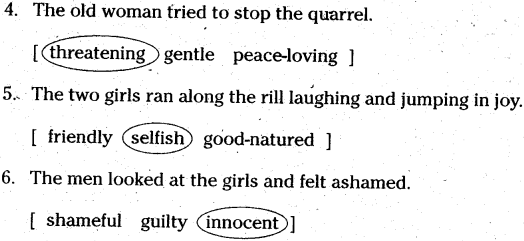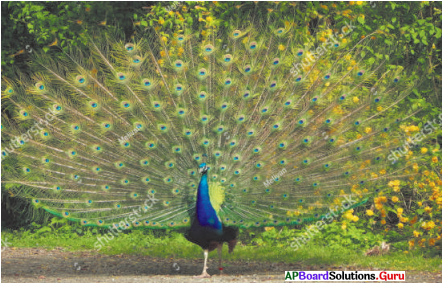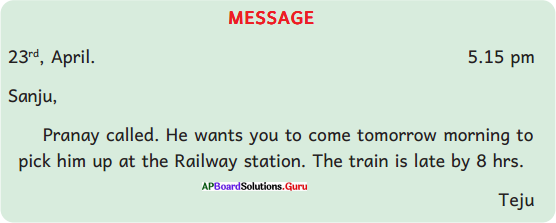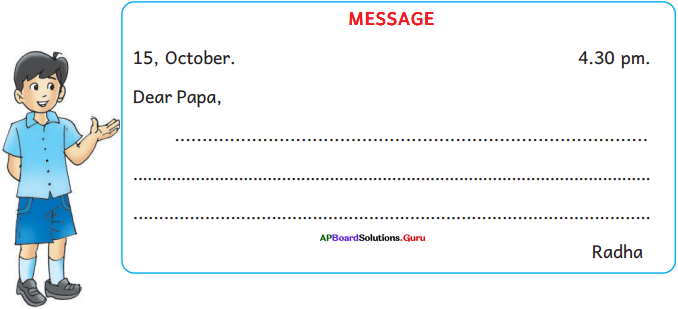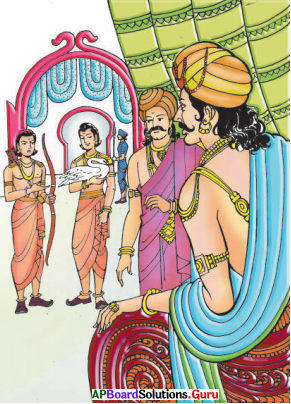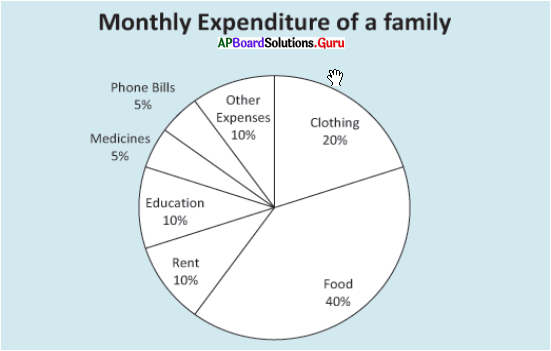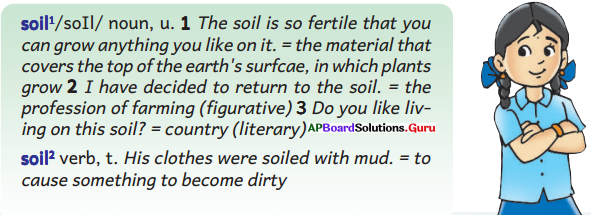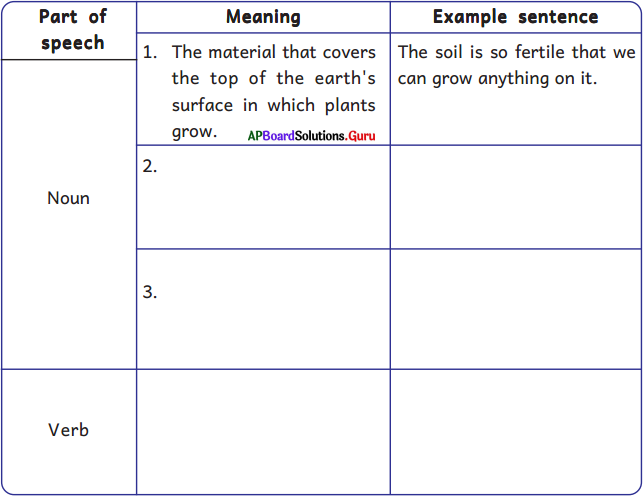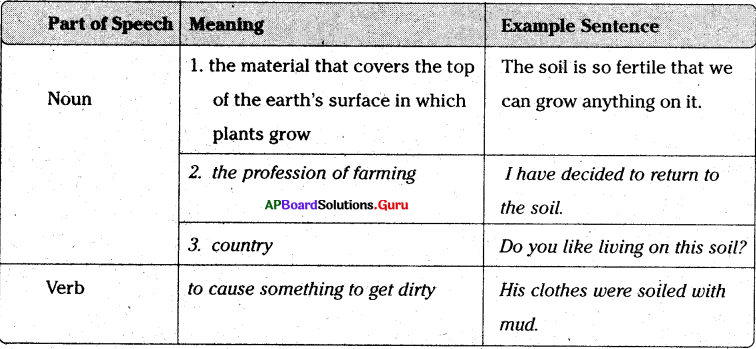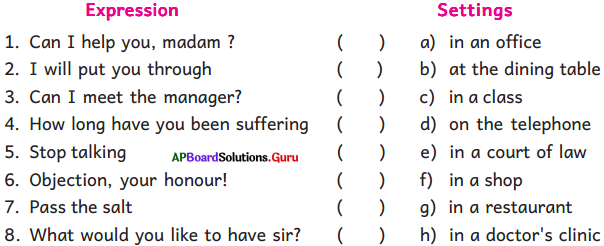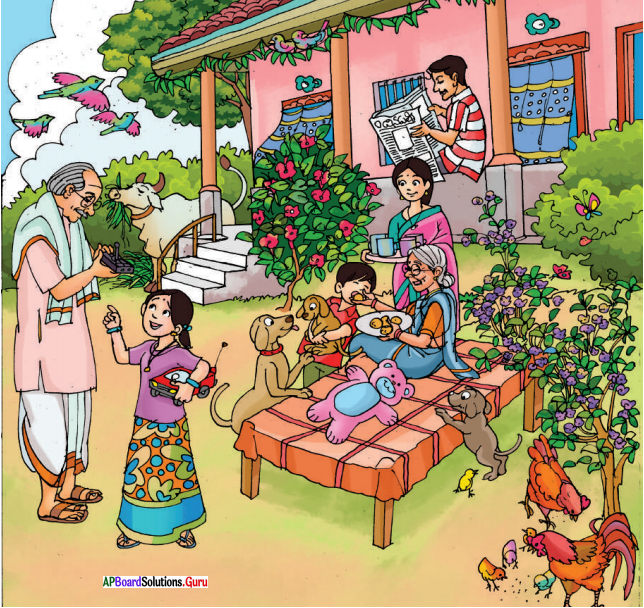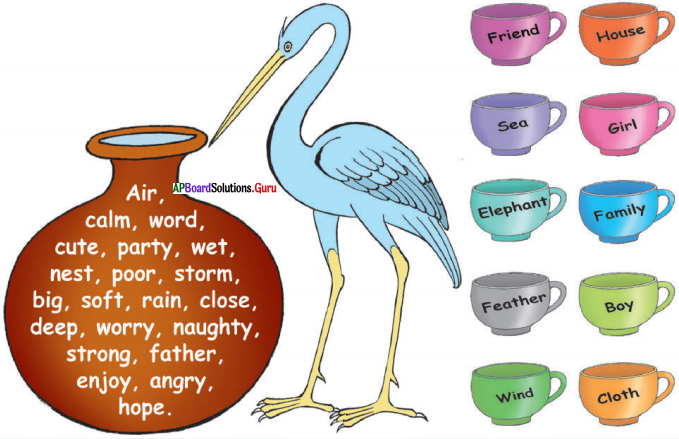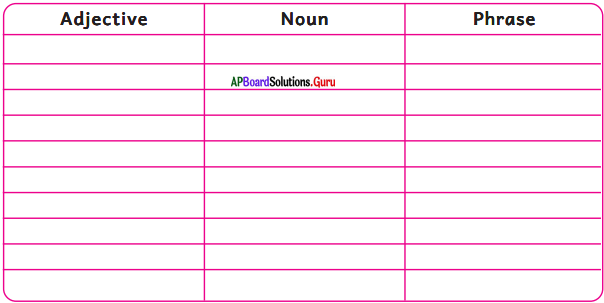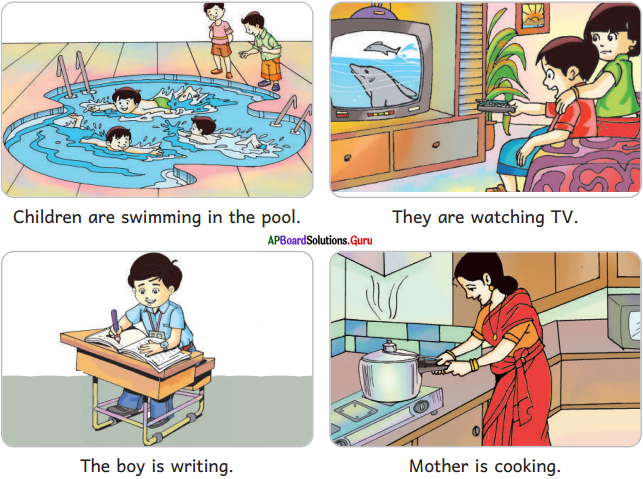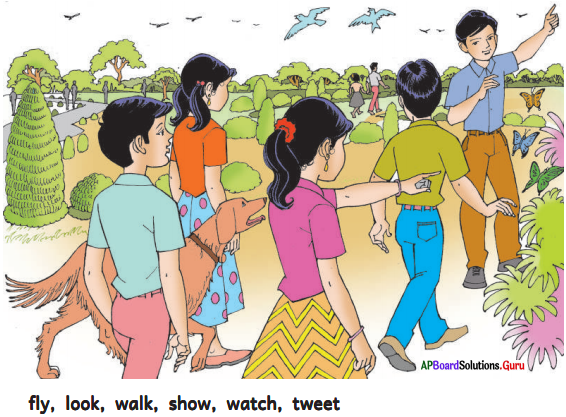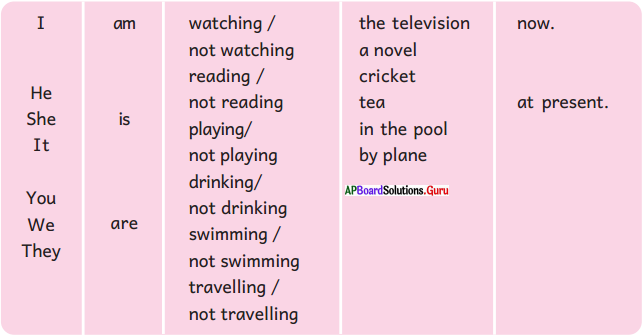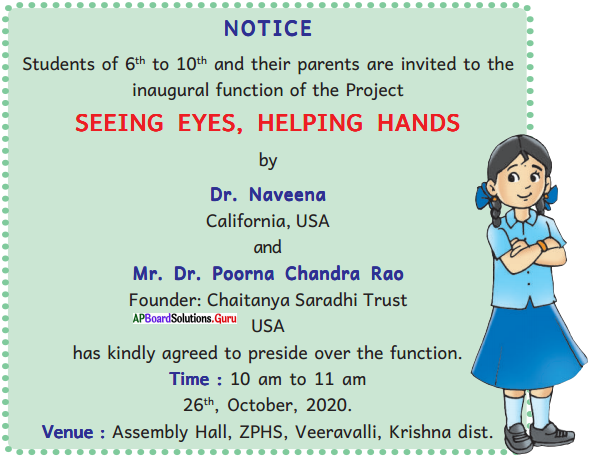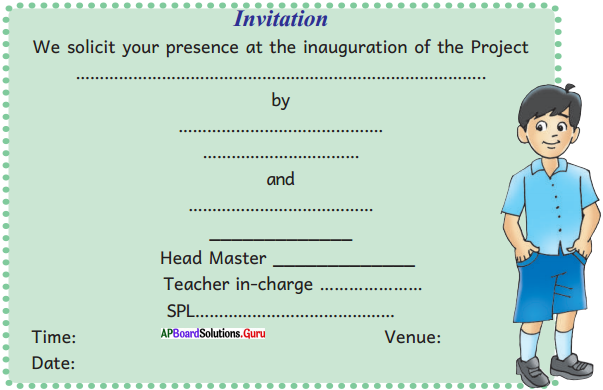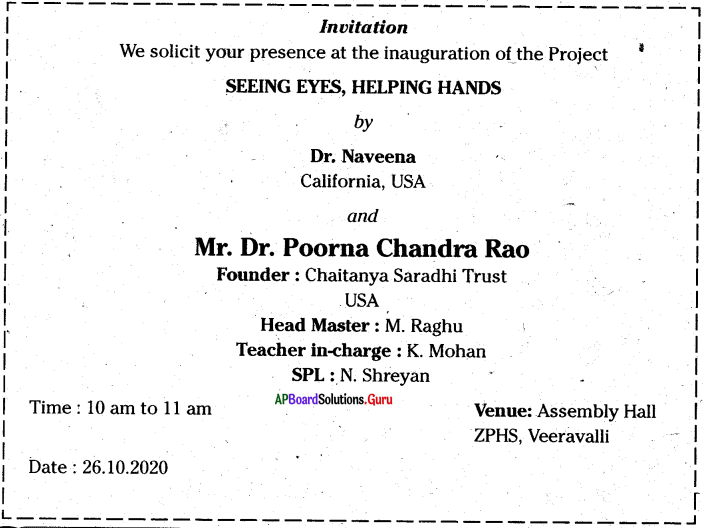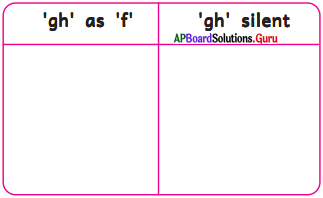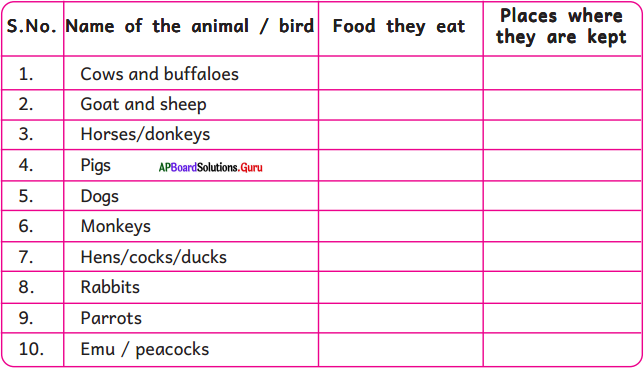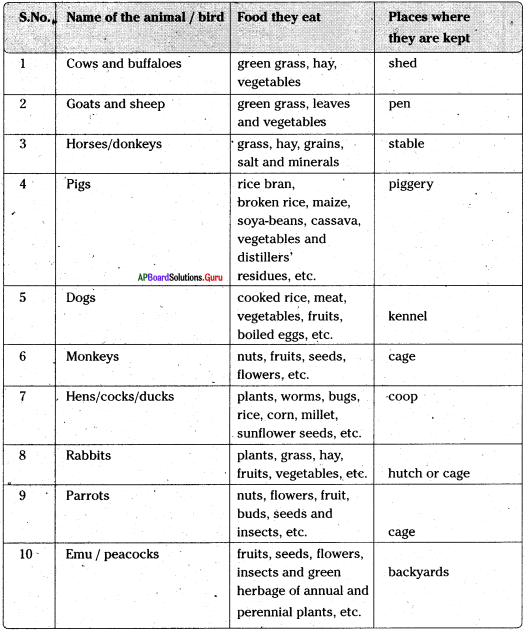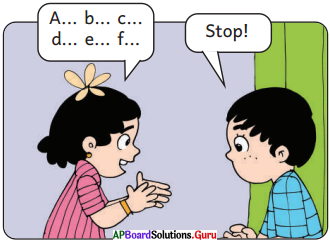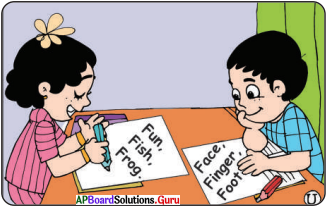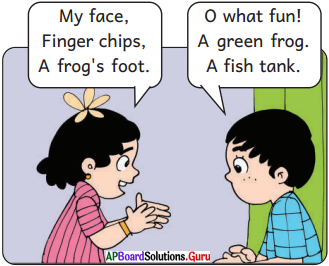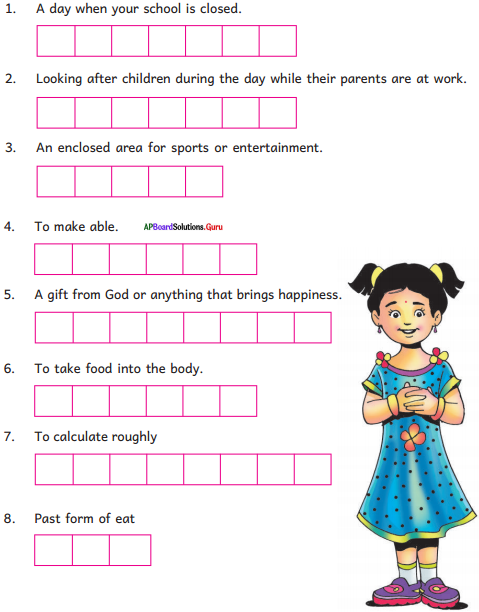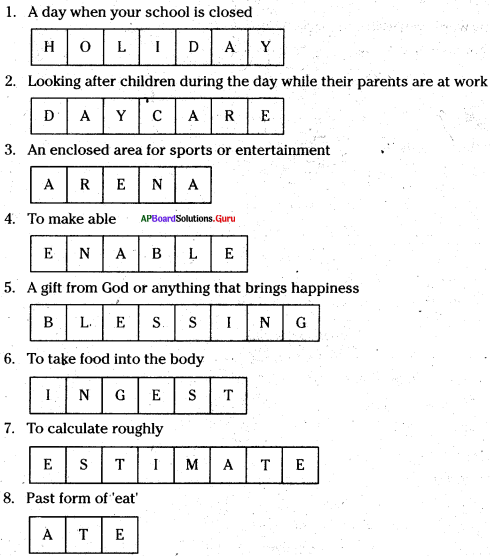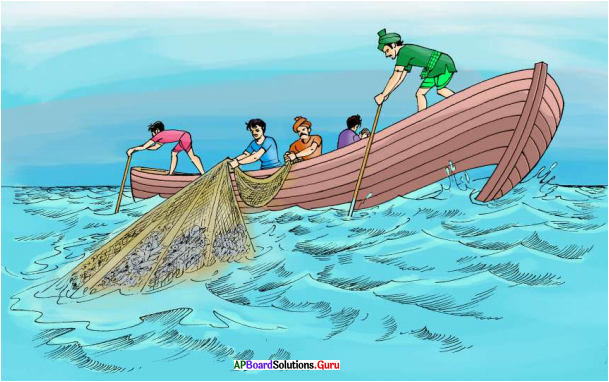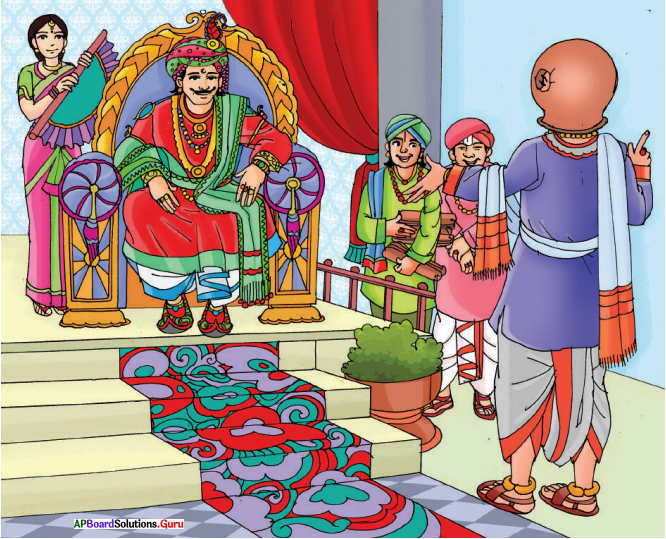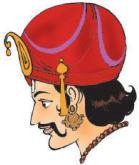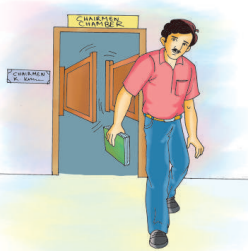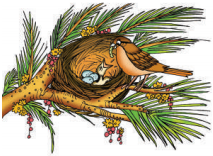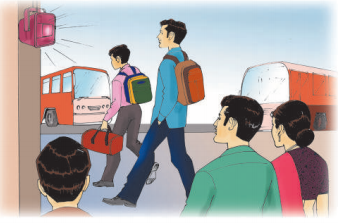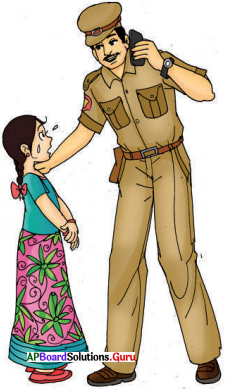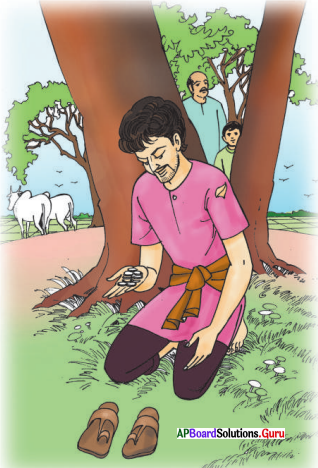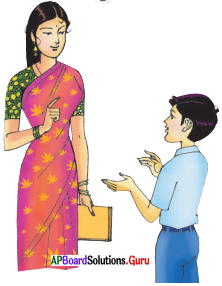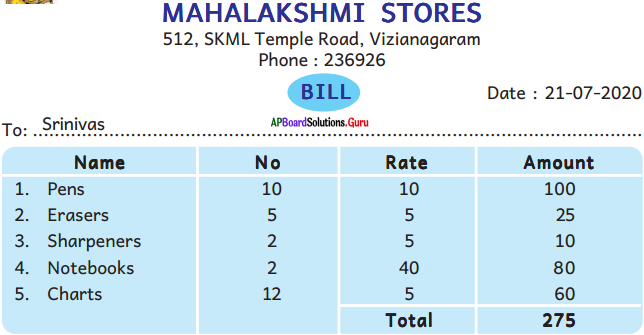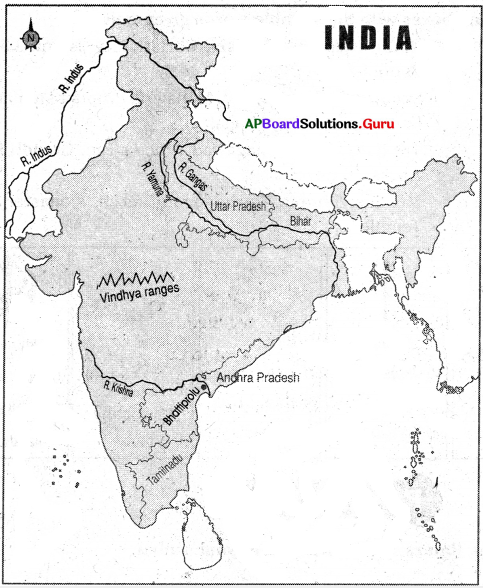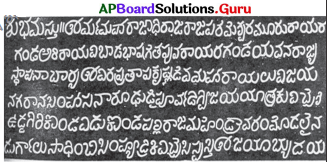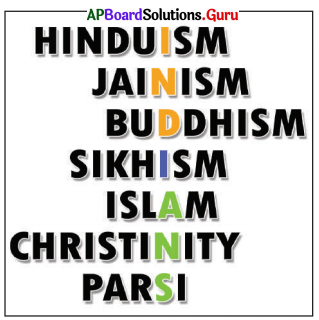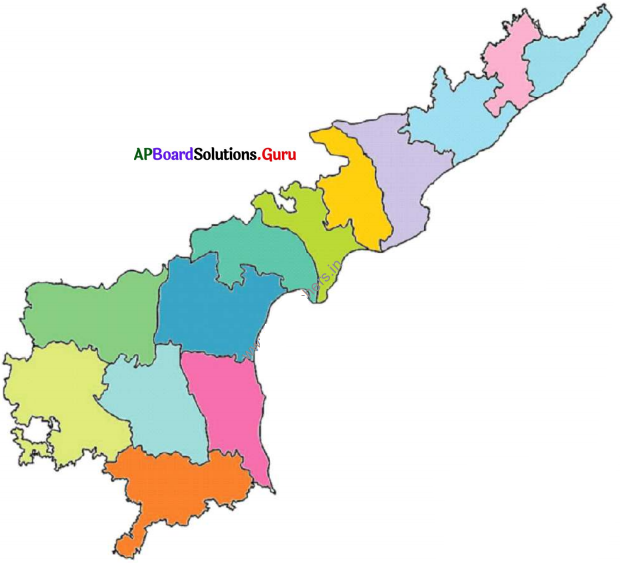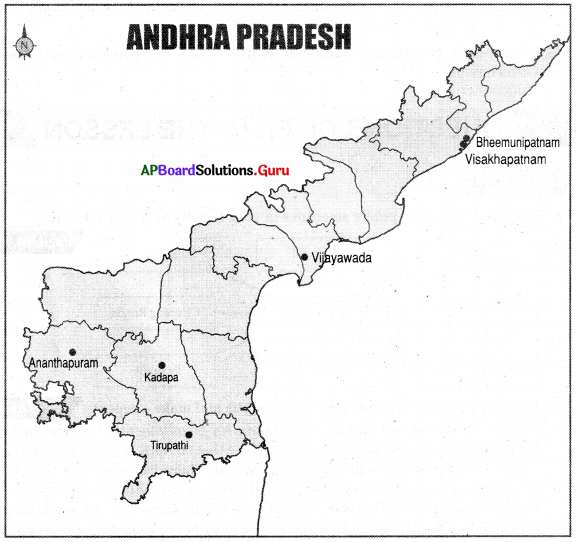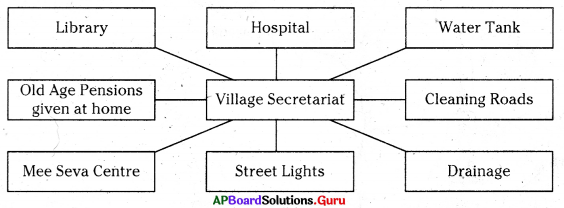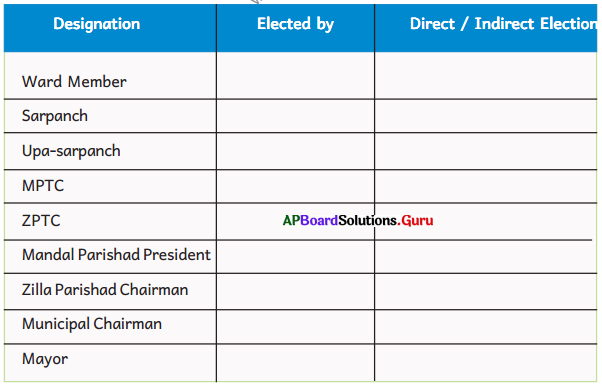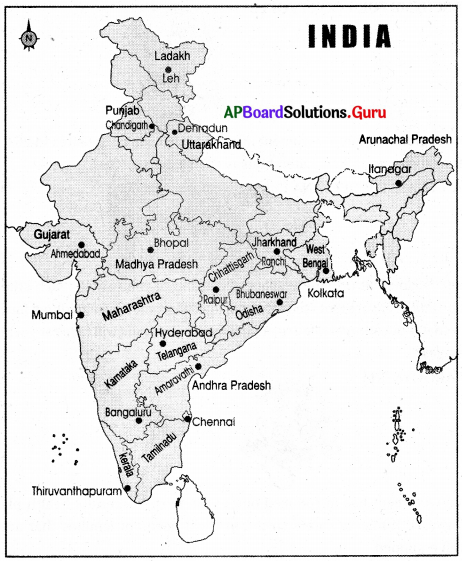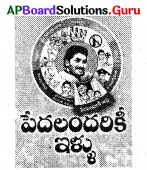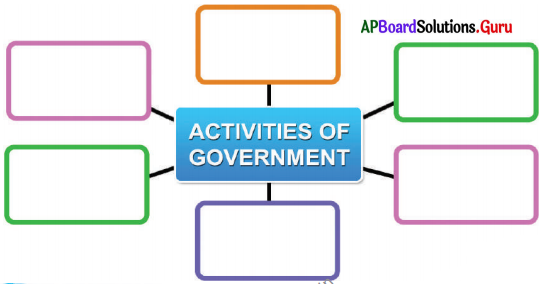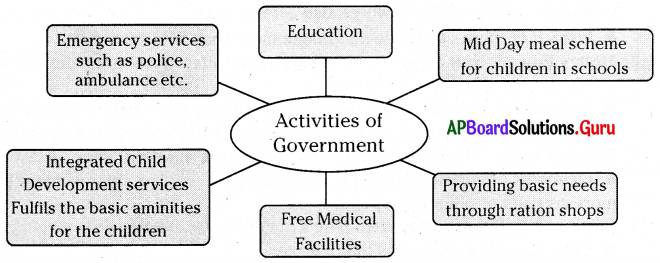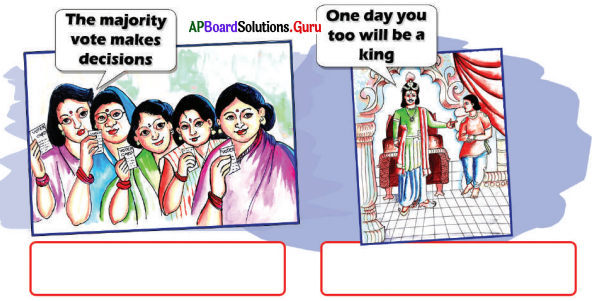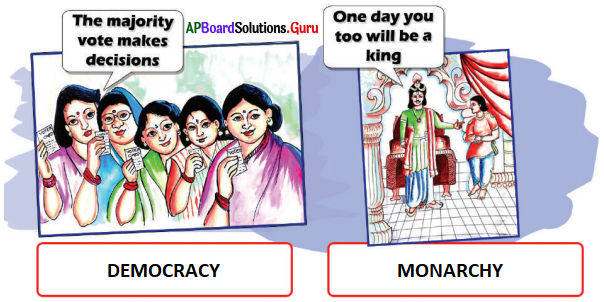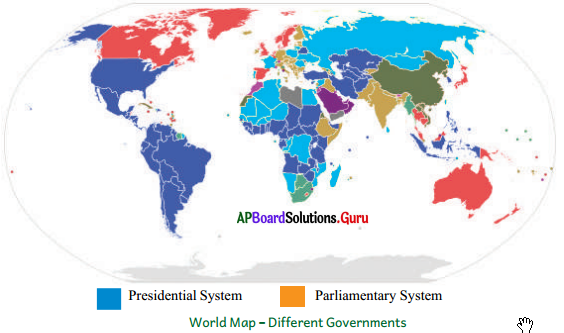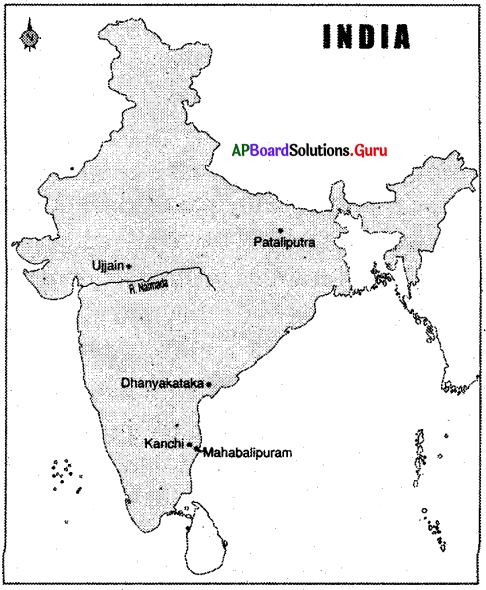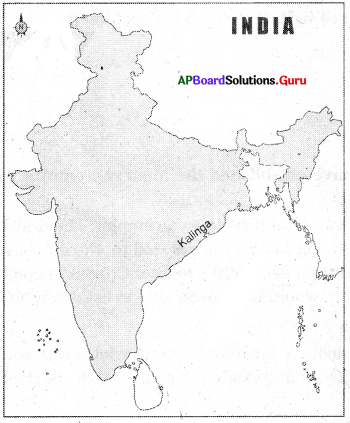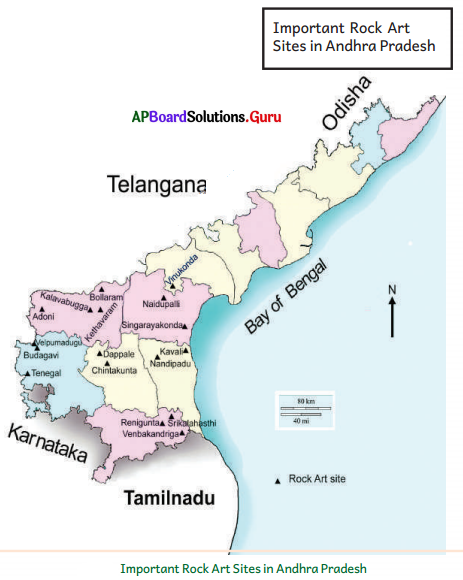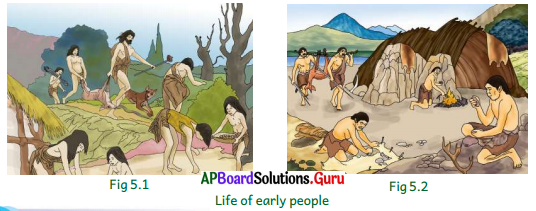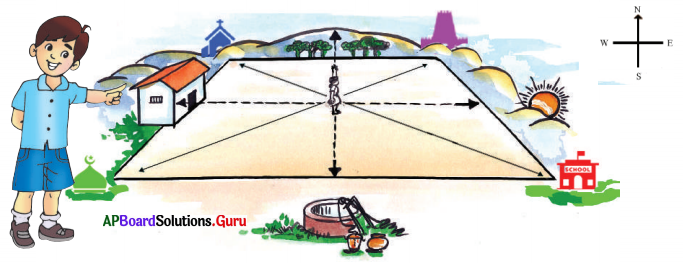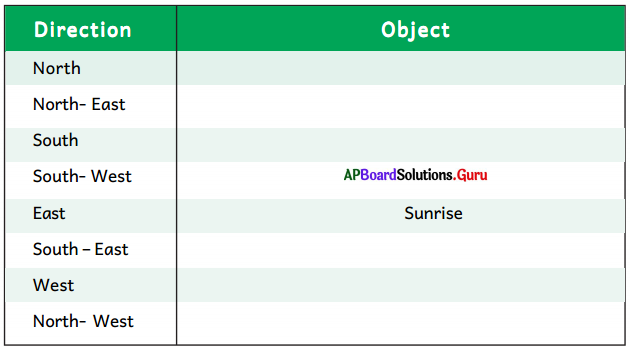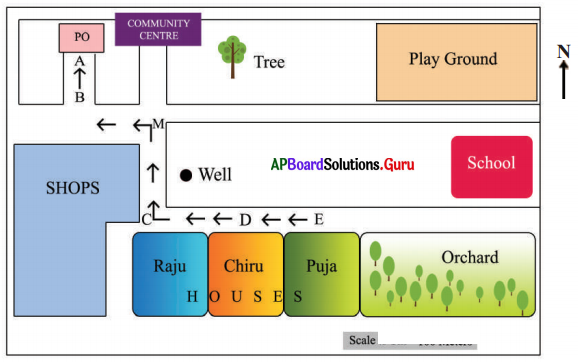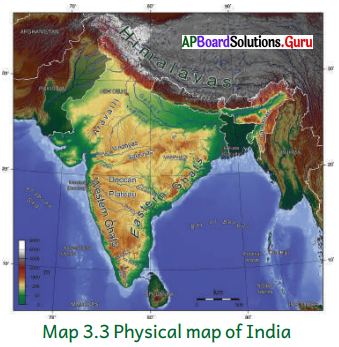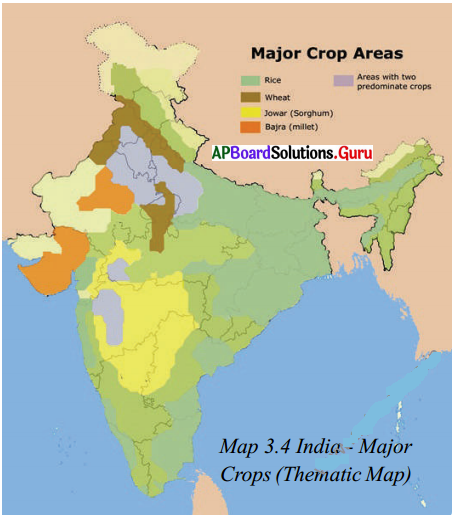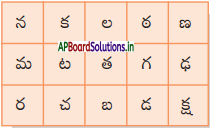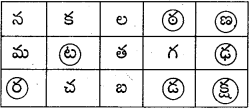SCERT AP Board 6th Class English Solutions 4th Lesson What Can a Dollar and Eleven Cents do? Questions and Answers.
AP State Syllabus 6th Class English Solutions 4th Lesson What Can a Dollar and Eleven Cents do?
6th Class English 4th Lesson What Can a Dollar and Eleven Cents do? Textbook Questions and Answers
Observe the following picture and answer the questions.

Question 1.
What can you say about the shop?
Answer:
It is a medical shop. Here we can buy medicines.
Question 2.
When does one go to such shops?
Answer:
One goes to such shops when one needs medicines.
Question 2.
Why do you think the girl has come to the shop?
Answer:
I think the girl has come to the shop to buy medicines for someone.
![]()
Question 3.
What do you think is the girl saying to the shopkeeper?
Answer:
I think the girl is requesting the shopkeeper to give some medicines.
Question 4.
Does she look happy? What makes you think so?
Answer:
I think she doesn’t look happy. I think someone who is very close to her is suffering from illness. So she is sad.
Question 5.
Who might be ill?
Answer:
Someone who is a relative
Reading Comprehension
I. Choose the correct answer.
1. Who was Andrew?
a) An eight year old child
b) Tess’s brother
c) Shopkeeper
d) Neurosurgeon
Answer:
b) Tess’s brother
2. “We don’t sell miracles here.” Who said these words?
a) Tess
b) Andrew
c) Chemist
d) Armstrong
Answer:
c) Chemist
![]()
3. The exact price of the miracle was
a) Dollar.
b) Eleven cents.
c) a dollar and eleven cents.
d) hundred cents.
Answer:
c) a dollar and eleven cents.
II. Say whether the following statements are True or False. Give reasons for your answer. Correct the false statements.
1. Andrew’s parents had very little money.
Answer:
True
2. Tess’s parents were very poor.
Answer:
True
3. Tess’s parents were not interested to take her little brother, Andrew, to the hospital.
Answer:
False
4. Andrew was seriously ill.
Answer:
True
5. Tess thought that “a miracle” was the medicine that was available in a medical store.
Answer:
True
Reasons:
- Andrew’s parents had very little money and, therefore, they couldn’t pay his doctor’s bills.
- Tess’s parents were very poor and so they were moving to a smaller house.
- Tess’s parents were interested to take her little brother, Andrew, to the hospital. But they had little money.
- Andrew was seriously ill and so he needed an operation.
- Tess thought that “a miracle” was the medicine that was available in a medical store and as such she asked the chemist to give her ‘a miracle’.
III. Tick the correct answer.
1. “I’m sorry,” the chemist said, because the miracle die girl had asked for……
a) was not available in his shop.
b) was very costly.
c) was not a medicine.
Answer:
c) was not a medicine.
2. Dr. Armstrong wanted
a) to help the child. t
b) to collect a lot of money,
c) to make fun of the child.
Answer:
a) to help the child.
IV. Answer the following questions.
Question 1.
Do you think less can buy the miracle with her savings? Why?
Answer:
I don’t think Tess can buy the miracle with her savings. Tess understands that the ‘miracle’ is also a kind of medicine and so she wants to buy it with the little money she has.
Question 2.
Why did the mother say that the surgery was a real miracle?
Answer:
The mother says that the surgery was a real miracle because their family was very poor. They couldn’t afford to $pend money for the operation. So they lost their hopes and gave up their efforts to save Andrew. At that time, Dr. Armstrong came as if he was a god and saved Andrew. So it was really a miracle for them.
![]()
Question 3.
What did the little girl understand by the word “miracle”?
Answer:
The little girl understood that ‘miracle’ was a kind of medicine.
Question 4.
What kind of a man was Dr. Armstrong?
Answer:
Dr. Armstrong was a man of generosity. When he understood Tess’s family position, without any other thoughts, he operated the boy without taking any money and succeeded. This incident shows us his helping nature.
Question 5.
Find out the words that have been used to describe Tess. Would you like to add some from your side?
Answer:
The words that have been used to describe Tess are ‘her eyes welling up’, ‘barely audible’ and ‘smiled’. Now l would like to add that she is a helpful, good-natured who has a lovable character. She determined to save her brother Andrew with the money she had.
Vocabulary
I. Read the following sentences.
Tess heard her parents talking.
She poured all the money on the floor.
Her mom whispered.
In the above sentences, the past forms of hear, pour and whisper are used to indicate completed actions.
Write the past forms of the following verbs.
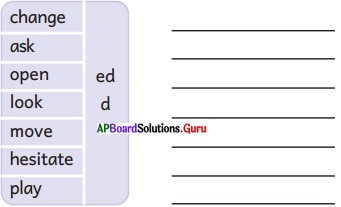
Answer:
changed
asked
opened
looked
moved
hesitated
played
II. Fill in the blanks with suitable words given in the box.
![]()
a) Last Sunday, I met my friends and we ……… for an hour.
b) My friend asked me to lend my gold chain to her. I ……….. to give it to her.
c) I heard some sounds in my room. I opened the door and ………… a small rat in the corner.
d) My father ………….. me to take a torchlight when I go out during nights.
e) He ……….. cricket yesterday.
Answer:
a) chatted
b) gave
c) noticed
d) cautioned
e) played
III. Read the following sentences.
My father is healthy. He never eats unhealthy food.
In the above sentences unhealthy is the antonym of healthy.
He understood me. But she misunderstood me.
Here the antonym is formed by adding ‘mis’ to ‘understood’.
We can form antonyms by adding certain prefixes to the words.
Make the opposites for the following, by adding suitable prefixes given in the brackets, (mis, un, im, dis, in, ir) Refer to a dictionary if necessary.
e.g. regular × irregular
A. discipline × …………………………
B. understand × …………………………
C. proper × …………………………
D: managed × …………………………
E. appeared × …………………………
F. comfortable × …………………………
G. known × …………………………
H. attentive × …………………………
I. happy × …………………………
J. real × …………………………
K. responsible × …………………………
Answer:
A. discipline × indiscipline
B. understand ×misunderstand
C. proper × improper
D. managed × mismanaged
E. appeared × disappeared
F. comfortable ×uncomfortable
G. known × unknown
H. attentive × inattentive
I. happy × unhappy
J. real × unreal
K. responsible × irresponsible
Grammar
I. Read the following sentences.
Tess smiled.
Tess answered.
The chemist said.
She knew that Andrew was sick.
All the above sentences speak about the actions completed in the past. They are said to be in the past tense. The verb used in such sentences is generally made by adding ‘ed’ or ‘d’ and by making some changes to their present tense form.
‘Said’ and ‘knew’ are the past forms of ‘say’ and ‘know’. Certain verbs like ‘cut’, ‘put’ are the same in their past form also. Verbs such as ‘sit’, ‘hold’ and ‘cut’ are called irregular verbs as they form their past tense differently.
Read the following table.
| Present Tense | Past Tense |
| reach | reached |
| add | added |
| touch | touched |
| play | played |
| visit | visited |
| avoid | avoided |
| complete | complete |
| die | died |
| live | lived |
| keep | kept |
| sit | sat |
| teach | taught |
II. Read the following text and fill in the blanks with the correct forms of the verbs given.
Last Sunday I …….(1)…….. (go) to Abhi’s birthday party. All my friends ………(2)…….. (gather) on that occasion. Rehman ………(3)……….. (play) music. John ……..(4)……… (sing) Hindi songs. Sobhan ………(5)……… (dance) to John’s songs. Abhi’s sister …….(6)…….. (distribute) sweets. Abhi ………(7)……… (cut) a cake. Abhi’s grandparents ……..(8)…… (bless) him. Abhi’s father ………(9)……. (present) him a new bicycle. Abhi …….(10)…….. (be) very happy. We all ……..(11)…….. (have) a good time.
Answer:
- went
- gathered
- played
- sang
- danced
- distributed
- cut
- blessed
- presented
- was
- had
III. Read the following pairs of sentences.
• She used to play with her brother.
• Ismail used to play kabaddi in his childhood. Now he plays tennis.
• Sarma used to watch English movies when he was eighteen. Now he watches Hindi movies only.
• Yasmin used to run five kilometers every morning when she was young. Now she walks two kilometers every morning.
‘Used to’ is used to speak about things that were habitually done in the past.
Now, write five sentences about the things you used to do when you were in Primary School.
Answer:
- I used to sit in the front row.
- I used to wear slippers.
- I used to eat chocolates.
- I used to go to school late.
- I used to play with my friends only.
Writing
I. Diary Writing
You have read in the story that the love of a little child saved the life of her brother. Andrew recovered completely and returned home. Tess was very happy. Let’s see what she wrote in her diary that night.
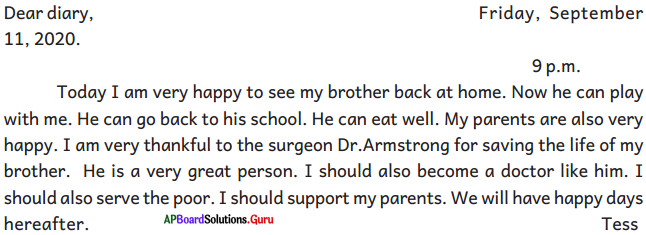
Now imagine yourself as Tess’s brother Andrew and write a diary entry for the day.
Answer:
Friday, September 11, 2020. Dear diary, Today I am very happy to be at home. Now I can play with my sister. I can go back to my school. I can eat well. My parents are also very happy. I am very thankful to the surgeon Dr.Armstrong for saving my life. He is a very great person. I should also become a doctor like him. I should also serve the poor. I should support my parents. We will have happy days hereafter. All the credit goes to my sister. Andrew |
![]()
II. Picture based story writing
Look at the picture and develop a story by using the words given in the box. Give a suitable title to the story. The beginning and the end of the story have been given. Write in your notebook.
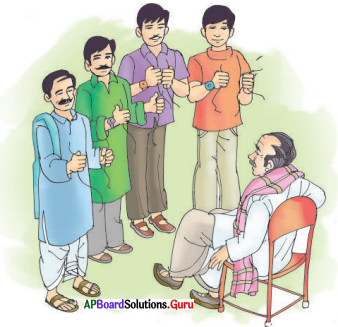
| a farmer – four sons – fell ill – quarrelled – sticks – broke – bundle of sticks – unable to break – decided not to quarrel |
Once there lived a farmer. He had four sons ………………………………. They decided not to quarrel. They lived happily.
Answer:
THE OLD MAN AND HIS FOUR SONS
Once there lived a farmer. He had four sons. The four sons always quarrelled with one another. One day the farmer fell ill. He was worried about his sons’ disunity and their future. He wanted to teach them a lesson to make them know the importance of unity. He called his sons. He gave them a stick each and asked them to break. The sons broke them easily. This time he gave a bundle of sticks each but the sons were unable to break them. They understood the value of unity. They decided not to quarrel. They lived happily.
Moral: Unity is strength.
Talking Time
I. Debate : You have read in the story about the family’s struggle to save the life of their son. Dr.Carlton Armstrong operated on Andrew without any charges. Andrew recovered completely.
Now read the following statement.
‘All persons in the society should be given free medical and health care.’
Debate the above issue.
[Two or three students who support the idea that free medical and health care should be provided to everybody’ should sit on one side. Two or three students who oppose the idea should sit on the other side. Each group should give their opinion on the topic. All the remaining students in the class ask questions, challenge them on their views and present alternative viewpoints to them. The teacher or a student from the class can play the role of a moderator/anchor.]
You may use the following expressions:
• I agree with you, but ……………..
• I disagree with you ……………..
• I strongly feel that ……………..
• I oppose what you say ……………..
Answer:
Moderator : You all know the topic of today. Let’s start with the Supporting Group.
Supporting Group : I think healthcare should be free because humans shouldn’t have to worry about if they can pay to stay healthy.
Moderator : Now it is the turn of Opposing Group. Let’s listen what they will say.
Opposing Group : Health care could not be free because it will never be free. Even if we make it affordable to everyone in our country it will never be “free” because we will have to find a way to cover the cost… And every indication points to this being covered by taxes being raised.
Moderator : Here is a question from audience to Opposing Group.
Question from audience (To Opposing Group) : What about the poor people who cannot afford medical expenditure?
Opposing Group : Nothing in life is “free.” Health care services that a person doesn’t pay for might seem “free” to that person, but it is being paid for by someone else. Any good or service that a person receives should be paid for, and the person should now how much it costs. A problem in the American healthcare system is that because of government healthcare (Medicaid and Medicare) and low insurance co-pays, people are completely out of touch with the true and exorbitant cost of healthcare.
Moderator : Here is a question from audience to Supporting Group.
Question from audience (To Supporting Group): Government should not be obligated to take care of people’s health simply because they pay taxes.
Supporting Group : Government run universal health care is the best way to bring down the costs of health care. On top of that, it frees up businesses from having to find insurance for their employees. It also brings down stress levels in individuals since they don’t have to worry about a major illness bankrupting them.
Moderator: It’s ok. Let’s stop the debate here. Both the groups expressed their opinion very well. They expressed some valid points.
I appreciate their efforts to make the debate successful. Thank you one and all.
![]()
II. Read the following sentences.
1. Show me the way to the railway station.
2. Please show me the way to the railway station.
3. Could you please show me the way to the railway station?
All these sentences are used for the same purpose. The second and the third are polite requests.
When we request somebody for something it is always better to be polite.
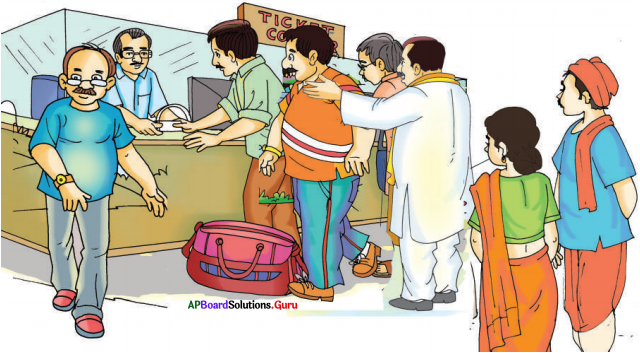
Read the following sentences which indicate politeness.
- Please tell me the arrival time of the Charminar Express.
- Please tell me the platform number of the Godavari Express.
- Could you please tell me about the wheel chair availability?
- Could you please tell me whether the Prasanthi Express is running on time or delayed?
- Could you please tell me the way to the cloak room?
Use the expressions in polite forms. Your classmate/teacher will help you.
A) Bring me some stamps from the post office.
B) Help me in getting down the train.
C) ‘Hold this bag for a while.
D) Wait for me at the tower clock.
E) Lend me hundred rupees. ‘
F) Tell me the bus number to Trunk Road. ‘
G) Watch my luggage till I come back.
H) Feed my pets for two days.
I) Close all the windows.
J) Reduce your TV volume.
Answer:
A) Could you please bring me some stamps from the post office?
B) Please help me in getting down the train.
C) Please hold this bag for a while.
D) Could you wait for me at the tower clock?
E) Could you please lend me hundred rupees?
F) Please tell me the bus number to Trunk Road.
G) Could you please watch my luggage till I come back?
H) Could you please feed my pets for two days?
I) Please close all the windows.
J) Please reduce your TV volume.
![]()
III. Imagine that you attended a function last evening. While everybody was in a happy mood, suddenly a snake entered the function hall. Somehow the organizers managed to catch it and handed it over to the zoo authorities.
Now narrate the incident to your friends. You may also narrate some other incidents you came across.
Answer:
Yesterday evening I attended a birthday celebration of my cousin who lives at Santosh Nagar. The function was arranged at S.R.K. Function Hall. My cousin cut the cake in a happy mood while others were cheering. All were in a happy mood. Suddenly one of my relatives cried, ‘Snake! Snake!’. All of us became panic and moved in all directions as we did not know where the snake was. All of us pushed the chairs and they fell down.
But nobody was hurt. Later we came to know that it was an old function hall and there were some rats here and there. A snake entered the function hall chasing a small rat. Our uncle saw that. He informed the organizers about the arrival of the snake. The organizers immediately arrived at the function hall with a snake catcher. He was able to catch it and handed it over to the zoo authorities. All of us sighed.
IV. Say the following words aloud.
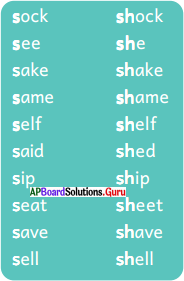
Refer to a dictionary and say two more pairs of words with ‘s’ and ‘sh’.
Answer:
| s | sh |
| sit | shit |
| sin | shin |
| sun | shun |
| sealed | shield |
| sour | shore |
| sink | shrink |
| sort | short |
| so | show |
| soot | shoot |
Project Work
Though Tess was a young girl and had a little money, she was able to save her brother. Collect a few success stories like that of Tess from magazines and newspapers. Talk about one of them in the class.
1. Kentucky Fried Chicken
The real-life story of Colonel Harland Sanders who was disappointed umpteen times in his life and still made his dream come true late in his life is really inspiring.
He is a seventh grade dropped out who tried many ventures in life but tasted bitter every time. He started selling chicken at his age of 40 but his dream of a restaurant was turned down many times due to conflicts and wars.
Later he attempted to franchise his restaurant. His recipe got rejected 1,009 times before the final approval. And soon the secret recipe, “Kentucky Fried Chicken” became a huge hit worldwide. KFC was expanded globally and the company was sold for 2 million dollars and his face is still celebrated in the logos.
Moral: Have you stopped your attempts to a venture just because you were rejected or failed a few times? Can you even accept a failure of 1009 times? This story inspires everyone to try hard and believe in yourself until you see success despite how many times you have failed.
2. Secret to Success
Once a young man asked the wise man, Socrates, the secret to success. Socrates patiently listened to the man’s question and told him to meet him near the river the next morning for the answer. The next morning Socrates asked the young man to walk with him towards the river. As they went in the river the water got up to their neck. But to the young man’s surprise Socrates ducked him into the water.
The young man struggled to get out of the water, but Socrates was strong and kept him there until the boy started turning blue. Socrates pulled the man’s head out of the water. The young man gasped and took a deep breath of air. Socrates asked, “What did you want the most when your head was in the water?” The young man replied, “Air.” Socrates said, “That is the secret to success. When you want success as badly as you wanted the air while you were in the water, then you will get it. There is no other secret.”
Moral: A burning desire is the starting point of all accomplishment. Just like a small fire cannot give much heat, a weak desire cannot produce great results.
Poem
MY DEPENDENCE
– Rabindranath Tagore
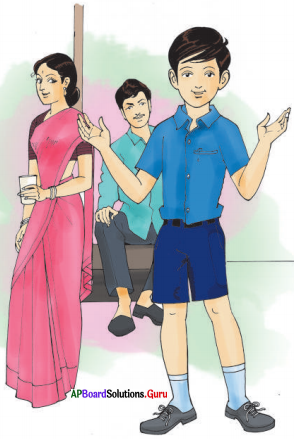
I like to be dependent, and so for ever
with warmth and care of my mother
my father, to love, kiss and embrace
wear life happily in all their grace.
I like to be dependent, and so for ever
on my kith and kin, for they all shower
harsh and warm advices, complaints
full wondering, true and info giants.
I like to be dependent, and so for ever
for my friends, chat and want me near
with domestic, family and romantic
tips colleagues.as well, guide me work at risks.
I like to be dependent, and so for ever
for my neighbours too, envy at times
when at my rise of fortune like to hear
my daily steps, easy and odd things too.
Appreciation
Question 1.
Identify the rhyming words for the following.
embrace –
complaints –
Answer:
embrace – grace; complaints – giants
Question 2.
How do our parents care for our happy life?
Answer:
The mother cares with warmth and the father kisses and embraces with love.
Question 3.
Why should we depend on our kith and kin?
Answer:
We should depend on our kith and kin for getting harsh and warm advices, complaints which are true, helpful and informative.
Question 4.
Do you think we need friends? Why?
Answer:
Yes, I think we need friends. They are always with us in our troubles.
![]()
Question 5.
What is the message of the poet in this poem?
Answer:
We are always dependent on others for many things throughout life. Without our parents, relatives, friends, and neighbours we can’t lead our lives happily. They are helpful for us in many ways. They shape our life.
Question 6.
Which phrase in the poem means ‘relatives’?
Answer:
Kith and kin
Question 7.
Be a poet. Try to complete the following poem with words that rhyme with each Other.
I’d love to live a life that’s f……….,
Relax under a shady t………..,
And fall into a dreamy s …p,
With no strict hours to k ……….,
And sing a merry s………..,
Untrodden paths, as I walk a………..g.
You ask me what I’d get to ………..?
Fruits and nuts and berries sw………..t.
You ask me with whom I’d get to p………..
Birds and animals, happy and g………..
And if a woodcutter put a c………..p
Firmly, I would put a st………..
So that’s the life I’d like to I………..d
Free from worries, free from gr………..d.
Answer:
I’d love to live a life that’s free,
Relax under a shady tree,
And fall into a dreamy sleep.
With no strict hours to keep.
And sing a merry song.
Untrodden paths, as I walk along.
You ask me what I’d get to eat?
Fruits and nuts and berries sweet.
You ask me with whom I’d get to play.
Birds and animals, happy and gay.
And if a woodcutter put a chop.
Firmly, I would put a stop.
So that’s the life I’d like to lead.
Free from worries, free from greed.
Fun Time
I. Say the following sentences as fast as you can. Dp it as a pair-activity.
A) She sells seashells by the seashore.
B) I scream, you scream, all scream for ice cream.
![]()
II. Read (sing) and enjoy.
There was a young man of Niger Who went for a ride on a tiger.
They returned from their ride,
With the man inside,
And a smile on the face of the tiger.
What Can A Dollar And F.T Fvfn Cents Do? Summary
Tess was an eight year old child. One day she heard that her brother, Andrew was very sick and he needed some operation to be alive. But their family was very poor. Her parents lost their hope and gave up their efforts. Tess heard from her daddy that only a miracle could save her brother. She thought that miracle’ was a kind of medicine. Think¬ing so, she took her jar of coinsi and went to a medical shop. She asked the chemist to give her a miracle by taking the money. The chemist sadly told her that miracles were not sold there. Dr. Carlton Armstrong, a famous neurosurgeon, heard their conversation. Then he asked her how much money she had. She replied that she had one dollar and eleven cents and also told she could manage to get some more. He told her that was the exact price of a miracle for her little brother and asked her to show their house. Dr. Carlton Armstrong admitted Andrew to hospital and operated on him without any charges. Andrew recov¬ered well. Tess’s mum whispered that it was a miracle and she wondered how much it would have cost. Only one person knew the answer to that. That is none other than Tess.
My Dependence Poem Summary
Tagore’s poem ‘My Dependence’ tells us how human beings are dependent on others from birth to death. Tagore says that he is dependent on parents for their care and grace. Later he depends on his relatives for advice. He says that he depends on friends and colleagues for guidance and close friendship. Sometimes he depends on his neighbours to hear the words of envy when he rises his fortune.
My Dependence Poem About the Poet
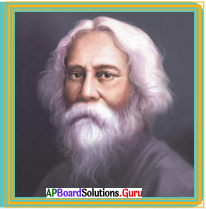
Rabindranath Tagore [1861-1941] was considered the greatest writer in modern Indian literature. A Bengali poet, novelist, educator, and Nobel Laureate for Literature [1913]. Tagore was awarded a Knighthood in 1915, but he surrendered it in 1919 in protest against the massacre at Amritsar.

